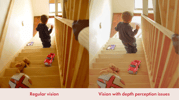Accessible gardening: How to transform your garden into an accessible and multifunctional haven with ‘Inclusive Chic’

Creating an inclusive and accessible garden shouldn’t mean an institutional-looking environment, devoid of your unique style. If you're a keen gardener, or want to develop your green fingers, garden accessibility does come with certain challenges - but the solution can be stylish.
So, how can you master accessible gardening - and what are some exciting ideas to try?
Our insightful gardening expert, Mark Lane highlights the importance and his top tips for considering a ‘Inclusive Chic’ garden: the principle of designing an accessible space that remains true to your unique style. Here’s how you can apply the principles – with ease – in your own garden haven.

Tip 2: Build a pathway
You can't have an accessible garden without access. But how can you make this inclusive and stylish?
You should consider a pathway or an outdoor stairlift if you need to get from the back or front door to a gate, shed or garage. Ideally, follow the guidelines from my blog on ‘How garden designers can create inclusive spaces’ and aim for a path 1.5-2.0 metres wide.
To stop wheels and feet from ending up in a flower bed, install a raised edge using a wooden gravel board (the board found at the bottom of a fence) or a concrete edger, proud c. 10 cm above ground level.
For the pathway, consider paving slabs rather than gravel, as gravel is very difficult for wheelchair wheels. Paving should be pointed with a minimum gap of 10 mm. You want a firm, stable, non-slip surface. In some instances, anti-glare paving slabs are a good idea, especially for partially sighted or people with sight loss. Alternatively, select self-binding gravel or resin-bonded/bound aggregate pathways. These have good slip resistance, are porous and are easy to maintain.
You can create a pretty patchwork pathway by using a mixture of tiles or smooth materials. Additionally, introduce fragrant shrubs or low-growing plants to soften your edges. There are plenty of varieties that will add colour to the sides of your walkway without creeping into it.
Consider lighting, too. Strategically placed solar-powered lights look magical at dusk and will light the path to enjoy your space later in the day.

Tip 3: Set up support rails
If you need to hold on to something when walking about the garden, consider hanging a rope through hoops or installing a support rail. Think about the material you want to use. Metal can be cold to the touch, especially in winter, whereas rope and wood are warm. Metal can be smoother, whereas wood and rope might need protecting and repairing.
Of course, there are plenty of plants that need support, too. Whether it's a frame for your sweet peas, elegant flower bed borders, walkway arches to encourage a plant canopy, or trellises to transform your clematis, you can match your style with your support rails for a cohesive look.

Tip 4: Raise the garden to new heights
Lifting the garden to a manageable height is key to a workable garden and accessible gardening; however, you don’t necessarily want the raised beds to look like an afterthought.
Think carefully when designing the whole space so that varied height raised beds add interest and become inclusive for all including wheelchair users. Another option is taller containers. If you put lockable wheels on the bottom of these, you can easily move them around your outdoor space.
The important thing to think about when raising your garden to a workable height is whether you plan to stand, sit, or do both when gardening. If you plan to sit down or use a wheelchair, raised tables are a great option, as you can get your legs and knees right under. Make it the perfect height for you.
If you’re planning a permanent raised bed, don’t make it wider than 1.2 m, especially if you can only access it from one side. Otherwise, it can be difficult to reach when gardening. It would be helpful if you tied the sleepers with metal rods, brackets, or cross-support frames. When laid in a brick formation, the walls of the raised bed will be stronger and last longer.
If you use treated softwood sleepers laid on their longer, flat edges, you can create a perching spot around the soil area so that you can do your gardening while sitting down. If using brick or block work, aim for a frame c. 20-30 cm wide, which is big enough to perch on.
Soil in raised beds will eventually drop, so liners are a good investment. They keep the soil within the raised bed but will not stop the soil from settling. The great thing is that it is easier to top up with compost or topsoil.

Tip 5: Create a multifunctional space for every occasion
If you’re tight on space, you might need to consider it as a multifunctional space. Choose folding a table and chairs to lift onto bike hooks, freeing up the floor for a drink party or a get-together. Fixed, fold-down barbecues, tables and work surfaces can be lifted out of the way and secured to the wall.
If you enjoy gardening, consider a vertical garden to grow veggies or fruit in a more limited space. Several are on the market now; some even come with individual pots for plants, so you can easily swap and change them around to get maximum sunlight.
It's important to note that all vertical gardens need an irrigation system, a leaky hose, small irrigation pipes and nozzles, and a water-collecting reservoir at the bottom. Using a solar-powered pump, you can put the watering onto a timer during the day and even add liquid feed to the reservoir. As the pump starts to work, the water and feed will be forced through the pipes and onto the soil or coir.
Vertical gardens can be quite high maintenance, but they can be made up of either ornamental or edible plants - so you can swap out the "needy" plants for more low-effort substitutes if your or abilities change.

Tip 6: Create a unique "inclusive chic" theme
How can you make a garden space that truly reflects your style, while helping you to enjoy gardening to its full extent?
Taking inspiration from other gardens is a great way to get started when thinking about the possibilities for your own space - and it can help you get creative with affordable solutions, too.
You might approach your own project thinking of a particular look or trend you've seen, such as cottage, prairie, sensory, tropical, seaside, modern or contemporary, for example. You might think of style in terms of organic and non-organic, using natural or manmade materials. Perhaps your interior design is Scandinavian chic, Art Moderne, Mid-Century, Shabby chic or Eclectic, and as you extend this to your garden, you'll reflect this here.
Increasingly, the growth of universal garden concepts, inclusive community gardens, and sensory garden design means there more bright ideas out there to complete your "inclusive chic" garden, too.
The great thing about "inclusive chic" is that it can adapt to whichever style suits you.
Natural materials in the garden, such as stone, gravel and wood, lend themselves to traditional styles. In contrast, clean-cut porcelain tiles, a monochrome palette, solid architectural features, and modern sculpture are better for modern or contemporary gardens. Remember, there are no rules other than your own. You can even mix up materials and aim for an eclectic look.
When it comes to the outdoors, few products can be used straight from the box to create an inclusive space; however, by thinking outside the box, your outdoor space can be an area for relaxation, partying, entertaining or chilling.
Making your ideal outdoor living space
Whether you want to bring more bright colours to your lawn, are keen to serve veg you've grown yourself, or are looking for inspiration to bring more life to your plant beds while maintaining a multifunctional space, there are plenty of tools at your disposal to ensure you can have the garden you want while embracing inclusive chic.
Whatever and however you choose and approach style, you can ensure its unique to you and compliments your living space.
There are some principles to consider - from furniture choices to pathway sizes - but these don't have to hold you back. Instead, it's additional inspiration to get creative and make a garden that you'll enjoy.
Curious about embracing the beauty of the outdoors into your indoor spaces? Find out what the principles of biophilic design are and how to incorporate them into your home and garden, or learn more about Inclusive Chic interior design to help make your house a more practical haven, too.
Stay up to date
Latest Blogs

Whole Home Comfort with Stannah and HSL

Dame Zandra Rhodes x Stannah: When accessibility meets style
Could more people benefit from home adaptation support for hidden disabilities?
50 years of Stannah Stairlifts – A milestone grounded in purpose

BBC’s Dr Punam Krishan reveals a little-known Parkinson’s symptom to watch for...

Are you at risk of falling? Dr. Punam Krishan’s simple 12-second test could tell you...

Snore Wars: Could sleeping separately be the secret to a better night’s rest?

Proud to carry the Made in Britain mark!
Stairlifts made for you
All our stairlifts whether straight or curved are customised to suit you and your home so call now to arrange a visit to get your FREE personalised quote!